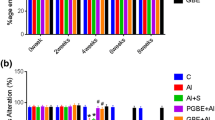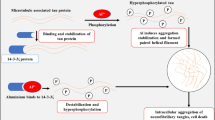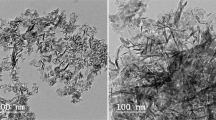Abstract
The effect of chronic aluminium exposure (25 mg/kg b.wt.) was studied on the lipid composition and various membrane-bound enzymes in different regions of monkey brain. Aluminium (Al) administration caused a significant decrease in the total lipid, glycolipid, and phospholipid content of primate brain. Cholesterol levels and the phospholipid to cholesterol ratio were, however, markedly increased as a consequence of Al administration, thereby indicating a loss of membrane integrity. This was further confirmed when Al treatment was found to have a significant effect on the various membrane-bound enzymes in terms of decreased activities of Na+ K+ ATPase and acetylcholinesterase along with a decrease in the activity of the myelin-specific enzyme, 2′ 3′-cyclic nucleotide phosphohydrolase.
Similar content being viewed by others
References
D. Julka, R. Sandhir, and K. D. Gill, Altered cholinergic metabolism in rat CNS following aluminium exposure: implications on learning performance,J. Neuwchem. 65, 2157–2167 (1995).
S. S. Krishnan, D. R. Mclachlan, A. J. Dalton, B. Krishnan, S. A. Stanley, J. E. Harrison, and T. Kruck, Aluminium toxicity in humans, inEssential and Toxic Trace Elements in Health and Disease. Alan R. Liss, pp. 645–659 (1988).
J. M. Candy, A. E. Dakley, and J. Klinowski, Alumino-Silicates and senile plaque formation in Alzheimer’s disease,Lancet ii, 354–357 (1986).
A. Bizzi and P. Gambetti, Phosphorylation of neurofilaments is altered in aluminium intoxication,Acta Neuropathol. 71, 154–158 (1986).
T. B. Shea, J. E. Clarke, T. R. Wheelock, P. A. Paskevich, and R. A. Nixon, Aluminium salts induce the accumulation of neurofilaments in perikarya of NB2a/dl neuroblastoma,Brain Res. 492, 53–64 (1989).
A. C. Alfrey, G. R. Le Gendre, and W. D. Kachny, The dialysis encephalopathy syndrome: possible aluminium intoxication,N. Eng. J. Med. 294, 184–188.
R. M. Strong, R. M. Garruto, J. G. Joshi, W. R. Mundy, and T. J. Shafer, Can the mechanism of aluminium neurotoxicity be integrated into a unified scheme?J. Toxicol. Environ. Health 48, 599–614 (1996).
C. G. Fraga, P. I. Oteiza, M. S. Golub, M. E. Gershwin, and C. L. Keen, Effects of aluminium on brain lipid peroxidation,Toxicol. Lett. 51, 213–219 (1990).
H. Zumkley, H. P. Bertram, A. Lison, O. Knoll, and H. Loose, Al, Zn and Cu concentrations in plasma chronic renal insufficiency,Clin. Nephrol. 12, 18–21 (1979).
J. Folch, M. Lees, and G. H. S. Stanley, A simple method for the isolation and purification of total lipid from animal tissues,J. Biol. Chem. 226, 497–509 (1957).
E. Levin and C. Head, Quantitative analysis of tissue neutral lipids,Anal. Biochem. 10, 23–31 (1965).
G. R. Bartlett, Phosphorus assay in column chromatography,J. Biol. Chem. 234, 466–468 (1959).
M. Dubois, K. A. Gilles, J. K. Hamilton, P. A. Rebbers, and F. Smith, Colorimetric method for determination of sugars and related substances.Anal. Chem. 28, 350–356 (1956).
A. Zlatkis, B. Zak, and A. J. Boyle, A new method for the direct determination of cholesterol,J. Lab. Clin. Med. 41, 486–492 (1953).
L. Warren, The thiobarbituric acid assay of sialic acids,J. Biol. Chem. 234, 1971–1975 (1959).
E. D. Wills, Mechanisms of lipid peroxide formation in animal tissues,Biochem. J. 99, 667–676 (1966).
P. D. Swanson, H. F. Bradford, and H. Mcllwain, Stimulation and stabilization of the sodium ion activated adenosine triphosphate of cerebral microsomes by surface active, especially polyoxyethylene ethers: actions of phospholipases and neuraminidase,Biochem. J. 92, 235–247 (1964).
J. B. Martin and D. M. Dotty, Determination of inorganic phosphate: modification of isobutyl alcohol procedures,Anal. Chem. 21, 965–968, (1949).
G. L. Ellman, K. D. Courtney, V., Jr. Anders, and R. M. Featherstone, A new and repid colorimetric determination of acetylcholinesterase activity,Biochem. Pharmacol. 7, 88–95 (1961).
J. R. Prohaska, D. A. Clark, and W. W. Wells, Improved rapidity and precision in the determination of Brain 2′,3′cyclic nucleotide 3′phosphohydrolase,Anal. Biochem. 56, 275–282 (1973).
O. H. Lowry, N. J. Rosebrough, A. L. Farr, and R. J. Randall, (1951) Protein measurement with Folin-Phenol reagent,J. Biol. Chem. 193, 265–275 (1951).
F. Islam, K. Tayabba, and M. Hasan, Organophosphate metasystox induced increment of lipase activity and lipid peroxidation in cerebral hemispheres: diminution of lipids in discrete areas of rat brain,Acta Phramacol. Toxicol. 53, 121–124 (1983).
J. P. Kehrer, Free radicals as mediators of tissue injury and disease,Crit. Rev. Toxicol. 23, 21–48 (1993).
D. Julka and K. D. Gill, Altered calcium homeostasis: possible mechanism of aluminium induced neurotoxicity,Biochim. Biophys. Acta 1315, 47–54 (1996).
M. L. Koenig and R. S. Jope, Aluminium inhibits fast phase of voltage-dependent calcium influx into synaptosomes,J. Neurochem. 49, 316–320 (1987).
S. Sarin, D. Julka, and K. D. Gill, Regional alterations in calcium homeostasis in the primate brain following chronic aluminium exposure,Mol Cell. Biochem. 168, 95–100 (1997).
M. Deleers, Cationic atmosphere and cation competition binding at negatively charged membranes: pathological implications of aluminium,Res. Commun. Chem. Pathol. Pharmacol. 49, 277–294 (1985).
M. Deleers, J. P. Servais, and E. Wulfert, Neurotoxic cations induce membrane rigidification and membrane fusion at micromolar concentrations,Biochem. Biophys. Acta 855, 271–276 (1986).
M. Cochran, D. C. Elliott, P. Brennan, and V. Chawtur, Inhibition of protein kinase C activation by low concentration of aluminium,Clin. Chim. Acta 194, 167–172 (1990).
P. E. Godiei and F. R. Landesberger,13C nuclear magnetic resonance study of the dynamic structure of lecithin: cholesterol membranes and the position of stearic acid spin labels,Biochemistry 14, 3927–3933 (1975).
S. Ando, Gangliosides in the nervous system,Int. Rev. Neurochem. 5, 507–537 (1983).
I. Kracun, H. Rosner, C. Cosovic, and A. Savlgenic, Topographical atlas of the ganliosides of the adult human brain,J. Neurochem. 43, 979–989 (1984).
H. Rahman, Functional indication of gangliosides in uraemic rats treated with 24R, 25-Dihydroxy vitamin D3,Neuropathol. Appl. Neurobiol. 15, 55–62 (1983).
G. J. Quinlan, B. Halliwell, C. P. Moorhouse, and J. M. C. Gutteridge, Action of lead (II) and aluminium (III) ions on iron stimulated lipid peroxidation in liposomes, erythrocytes and rat liver microsomal fraction,Biochim. Biophys. Acta 962, 196–200 (1988).
P. Oteiza, Aluminium has both oxidant and antioxidant effects in mouse brain membranes,Arch. Biochem. Biophys. 300, 517–521 (1993).
P. Ott, Membrane acetylcholinesterase: purification, molecular properties and interactions with amphiphilic environments,Biochim. Biophys. Acta. 822, 375–392 (1985).
J. C. K. Lai, J. F. Guest, T. K. C. Leung, L. Lim, and A. N. Davison, The effect of cadmium, manganese and aluminium on Na+ K+ activated and magnesium activated adenosine triphosphatase activity and choline uptake in rat brain synaptosomes,Biochem. Pharmacol. 29, 141–146 (1980).
B. Roelofson, The specificity in the lipid requirement of calcium and (sodium plus potassium) transporting adenosine triphosphatase,Life Sci. 29, 2235–2247 (1981).
A. G. Garcia, and S. M. Kirpekar, Inhibition of Na+K+ATPase and release of neurotransmitters,Nature 257, 722 (1975).
G. L. Schimdt, Development of biochemical activities associated with myelination in chick brain reaggregate cultures,Brain Res. 87, 110–113 (1975).
K. A. Funk, C. H. Liu, B. W. Wilson, and R. J. Higgings, Avian embryonic brain reaggregate culture system, I: characterization for organophosphorus compound toxicity studies,Toxicol. Appl. Pharmacol. 124, 149–158 (1994).
Author information
Authors and Affiliations
Rights and permissions
About this article
Cite this article
Sarin, S., Gupta, V. & Gill, K.D. Alterations in lipid composition and neuronal injury in primates following chronic aluminium exposure. Biol Trace Elem Res 59, 133–143 (1997). https://doi.org/10.1007/BF02783238
Received:
Accepted:
Issue Date:
DOI: https://doi.org/10.1007/BF02783238




